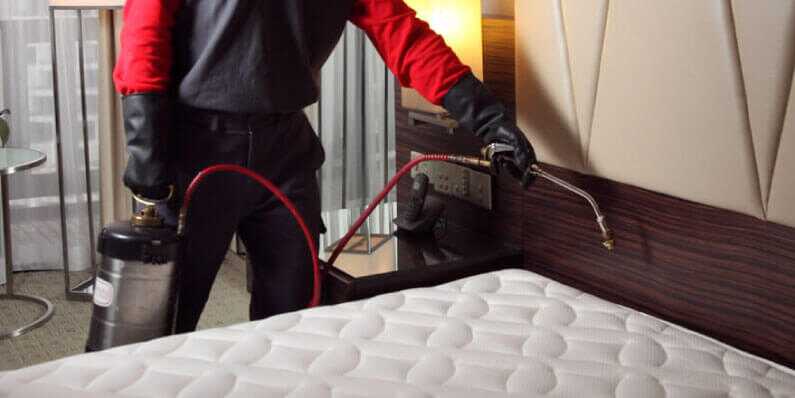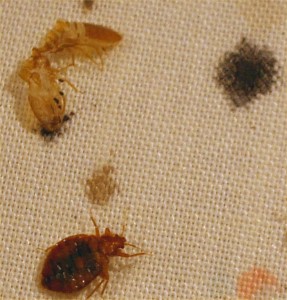Discovering the Science Behind Bed Insect Warmth Treatments as a Sustainable Bug Monitoring Technique
One such approach that has actually obtained grip in current years is the use of warmth treatments to fight bed insect invasions. The ins and outs of exactly how heat properly removes bed pests and the wider ramifications for sustainable pest monitoring methods make this a subject worth exploring further.
Bed Pest Warm Treatment Process

Thermal Death Point for Bed Bugs
Exposing bed bugs to raised temperature levels past their thermal tolerance range is essential for accomplishing efficient removal in heat therapy procedures. The thermal death factor for bed pests describes the temperature at which these insects can not survive. Study suggests that bed insects start to die when subjected to temperature levels above 113 ° F(45 ° C) for a sustained duration. As the temperature enhances, so does the death price of bed insects. At around 118 ° F(48 ° C ), bed insects start to pass away rapidly, with a death rate of nearly 99% within mins of exposure. This demonstrates the level of sensitivity of bed bugs to high temperature levels and highlights the performance of warmth treatments in eliminating problems. By reaching and keeping temperatures over the thermal death factor for bed bugs, parasite administration professionals can make sure detailed elimination of bed pest populations, consisting of hard-to-reach areas where chemical treatments might be much less reliable. Understanding the thermal fatality point for bed insects is vital for applying successful warm therapy techniques and attaining sustainable bug management end results.
Benefits of Warmth Treatments
Having developed the essential thermal fatality point for bed pests, it is crucial to now discover the substantial benefits that warmth treatments offer in properly eliminating these resistant parasites. One of the main benefits is that warm can pass through deep into holes and fractures where bed pests hide, making sure that even the most hard-to-reach areas are heated up to lethal temperature levels.
Additionally, warm therapies are environmentally pleasant and safe, making them a lasting insect monitoring strategy. Unlike chemical pesticides, heat treatments do not leave hazardous deposits that can posture risks to human health and wellness or the atmosphere. This use this link facet is particularly essential in delicate settings such as healthcare facilities, colleges, and houses where chemical use might not be preferable.
In addition, heat therapies have a high success price in removing bed bug invasions in a single treatment, lowering the demand for numerous brows through and lessening interruption to occupants. This effectiveness not only conserves money and time however likewise supplies comfort to those managing bed bug problems.
Efficiency of Warm Therapy

Heat therapies have actually the added benefit of eliminating bed pest eggs, which are usually immune to conventional chemical treatments. In general, the efficiency of warmth treatments in getting rid of bed my review here pest invasions makes them a trusted and lasting pest monitoring approach.
Sustainable Parasite Administration Conveniences
Applying lasting insect administration practices provides long-lasting benefits for both the environment and public health. By using techniques such as warmth therapies for pest control, we can decrease the dependence on hazardous chemical pesticides that can have adverse effects on ecological communities and human wellness - bed bug treatment. Sustainable pest administration techniques assist in maintaining biodiversity by targeting details bugs without damaging non-target organisms, therefore keeping a balanced ecosystem
Additionally, sustainable insect administration techniques contribute to the general wellness and wellness of the general public. By minimizing exposure to hazardous chemicals made use of in conventional insect control techniques, heat therapies offer a more secure option for pest management in property, commercial, and public areas. This decrease in chemical use additionally assists in protecting against pesticide deposits from infecting dirt, water, and air, safeguarding ecological high quality.
Conclusion
To conclude, bed pest warm treatments have been shown to be a effective and find lasting bug administration approach. The thermal death factor for bed bugs makes them susceptible to warm treatments, which have numerous benefits over conventional chemical therapies. The effectiveness of warm treatments in removing bed bug invasions while lessening ecological impact highlights the capacity of this method as a sustainable solution for bug control.
The bed pest heat therapy procedure involves elevating the temperature level within ravaged locations to a level that efficiently removes bed insects and their eggs. By getting to and maintaining temperatures over the thermal fatality factor for bed insects, parasite administration professionals can guarantee thorough removal of bed pest populaces, including hard-to-reach areas where chemical treatments might be much less efficient. One of the main advantages is that warmth can penetrate deep right into splits and holes where bed insects conceal, making certain that even the most hard-to-reach locations are warmed to lethal temperatures. Unlike chemical therapies that may leave behind resistant populations, warmth treatments provide a eco friendly and non-toxic solution that can permeate deep into furniture, wall surfaces, and other hard-to-reach locations where bed bugs hide.
The thermal fatality factor for bed pests makes them prone to warmth treatments, which have various benefits over standard chemical treatments.